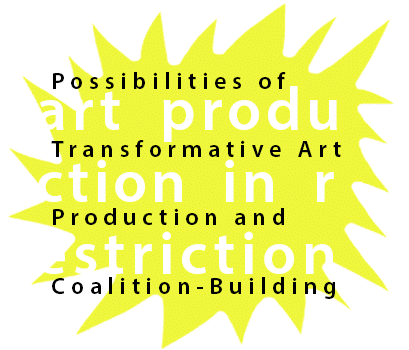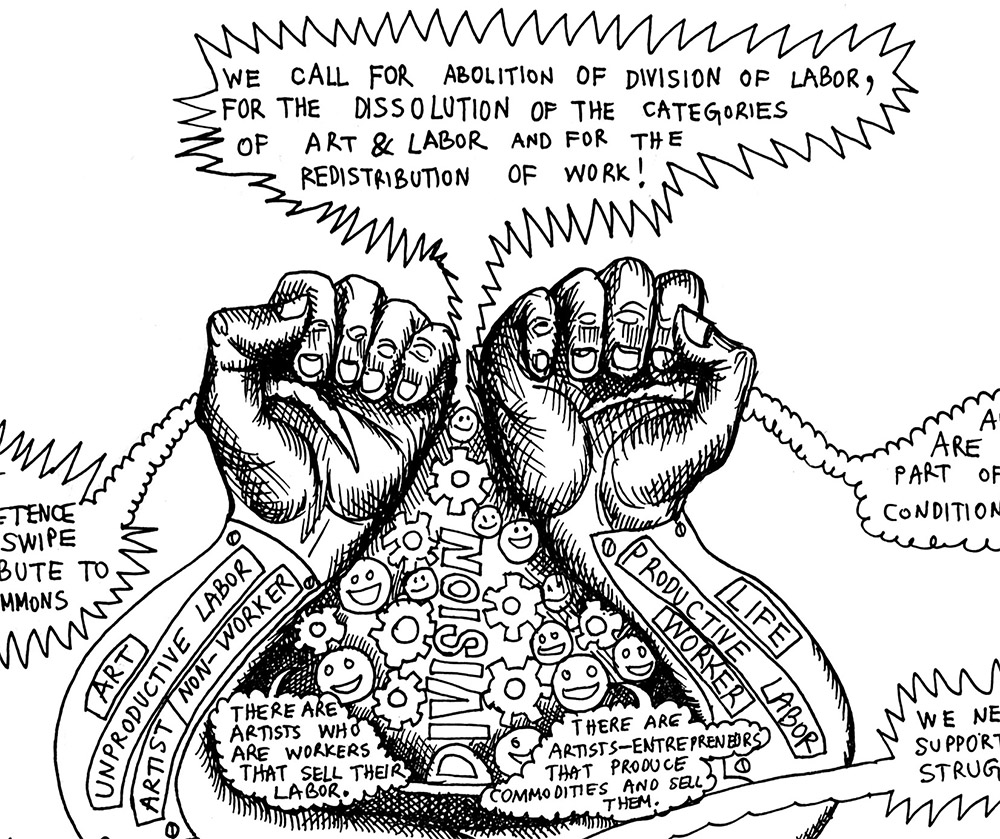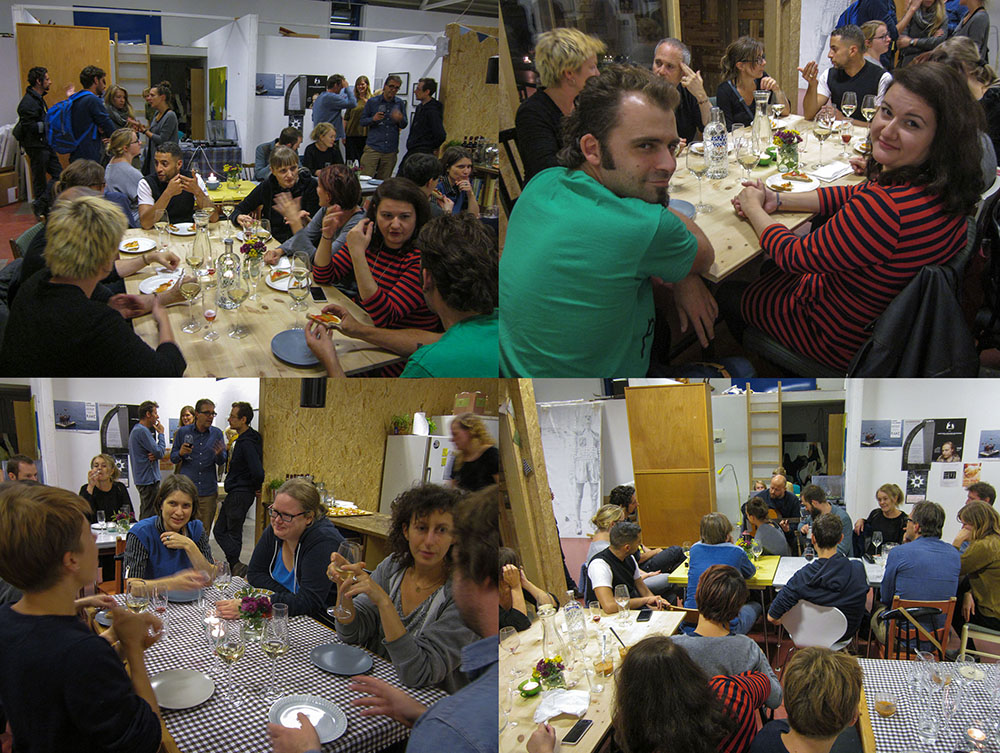Conclusions of the Trondheim Seminar
The Trondheim Seminar
This paper presents the conclusions of the Trondheim Seminar on transformative art production and coalition-building, curated in September 2015 by Rena Raedle and Vladan Jeremic as guest curators at LevArt.
The seminar “Art Production in Restriction – Possibilities of Transformative Art Production and Coalition-Building” held in Trondheim, Norway had brought together artists, writers, critics, and curators who are active in groups that are struggling for better working conditions in the arts and society at large. Throughout the course of two days participants discussed theoretical conceptions of artistic labor and precarity, exchanged local and trans-local experiences in confronting the neoliberal entrepreneurial mode of art production, and strategized ways of transformative and emancipatory art production and organizing.
Since the neoliberal attack on public institutions of art and art education, artistic work has become an entrepreneurial activity within a restrictive framework conditioned by the expanding art market and hegemonic political agendas prescribing the usefulness of art. The division of labor in the creative and knowledge industries has formed huge masses of artists that serve as a ‘reserve army’ for cheap creative labor.
In recent years artists have organized themselves in new ways, developing strategies to push for better labor conditions and secure standards for minimum payment of artistic work. Major discussions dealing with the conditions of artistic production address the precarity that artistic labor has in common with other branches of ‘immaterial’ and reproductive, or ‘invisible’, labor. In this context, artistic work is seen as a model for highly-exploitative working relations in late capitalism. To understand what kind of precarity is at stake one needs to take into account the whole process of production and the position of the artist within it.
Obviously, we should distinguish between the precarity of Thai berry pickers working in the forests of Finland and Norway and the position of artists that, believing in the idea of liberated work, have to labor under precarious conditions. Less obvious, but no less real, are the different levels of precarity due to the social stratification of the art world. This encompasses artists producing pieces for the art market, artists working in art management and administration, and community and non-profit oriented art practices.
In examining these differences and contradictions, with conditions varying considerably between the peripheries and centers of capital, between the global South and North, can the general precarity of art production be seen to function as a common denominator in artists’ struggles for better working conditions? Or, do we need a different political basis for coalition-building that would be realized in a different model of production? How can a different production model support coalition-building? In such a setting, can the autonomy of artistic production become an emancipatory force, or should artists join social movements and political parties of the new left that aim for non-capitalist transformation?
The contributors to the seminar “Art Production in Restriction. Possibilities of Transformative Art Production and Coalition-Building” investigated these and other questions with the aim to come up with a joint paper that contains findings, agreed points and recommendations.
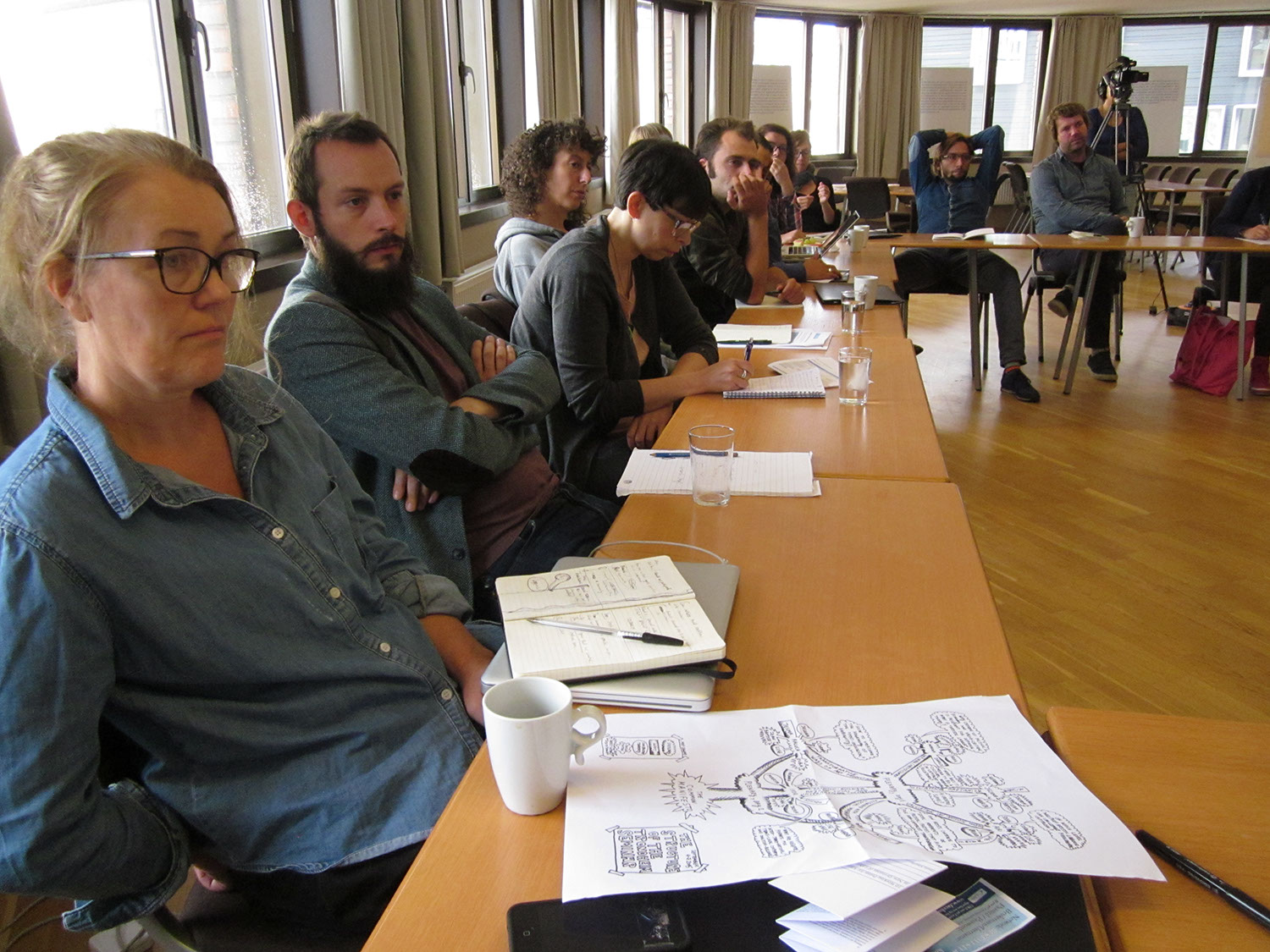
The seminar started with a welcome speech by leading curator Anne-Gro Erikstad on behalf of the inviting institution from Levanger. She briefly introduced the activities and mission of LevArt, a project space for contemporary art of the Levanger Commune. Erikstad stressed the urgency of the seminar themes in the times when neoliberal reforms of cultural policies in Norway have serious negative impacts on artists’ working conditions. After that, the organizers of the seminar, Rena Raedle and Vladan Jeremić, guest curators at LevArt project space, greeted the guests. They explained the proceedings of the seminar with the aid of a drawing they had prepared.
To reserve as much time as possible for exchange and discussion, the seminar was organized in working groups. Relevant papers and materials were shared during the preparation phase and published at the seminar Online Compendium at transformativeartproduction.net. The results of the working groups were presented in public plenary sessions in the afternoon.
In the evenings, a Mini Book Fair was organized that featured publications and artists’ editions dealing with the topics of art and work. Seminar participants and artists and writers from Trondheim presented their publications to the audience: Minna L. Henriksson and Airi Triisberg presented their book “Art Workers – Material Conditions and Labor Struggles in Contemporary Art Practice” covering experiences from Finland, Sweden and Estonia, Kuba Szreder introduced the publication “Joy Forever: The Political Economy of Social Creativity” by Free/Slow University of Warsaw, Gregory Sholette presented his book “Dark Matter: Art and Politics in the Age of Enterprise Culture” and the brand new publication “The Gulf: High Culture/ Hard Labor” about the campaigns and actions of Gulf Labor Coalition. Anne-Gro Erikstad presented Lisa Stålspets artist book “A home for Artists” and Corina L. Apostol presented the ArtLeaks Gazette No.3.
The installation “10 working days”, a re-reading of Peter Weiss’s “Ten Working Theses of an Author in the Divided World” from 1968 and contribution by Florian Schneider’s research group at the Trondheim Art Academy was at display in the seminar premises. With the idea to get a glimpse of translocal history of the place, the first evening an excursion to the Falstad Memorial center of the SS-prison camp at Falstad in Levanger municipality about one hour bus drive north of Trondheim was organized. The last evening the group was kindly hosted for a beautiful dinner served by Heidi-Anett & Lena Katrine alias Kunstkantina and a wonderful never-ending party at Rake Workcommunity at Svartlamon.
Below we will give summaries of the six plenary sessions, where the results of the working groups were presented and discussed. After that follows a conclusion with findings, agreed points and recommendations that were derived from the discussions during the seminar. The textual conclusion is accompanied by the drawing “Contradictions and Transformative Trajectory of Art & Labor”.
Summaries of the Plenary Sessions
Plenary Session 1, 5 September 2015
Working group 1:
Defining (artistic) work: artistic labor / precarious work / unpaid labor / reproductive work / flexible work/ forced labor
Contributors: Marina Vishmidt (presenter), Jesper Alvær, Noah Fischer, Marius Lervåg Aasprong, Danilo Prnjat, Rena Raedle, Gregory Sholette.
The input for the working group on definitions of artistic labor was given by Danilo Prnjat. He reflected the notion of the ‘art worker’ in the context of the avant-garde and posed general questions on participation. In the following discussion, the contradictions in defining artistic labor were drawn up and it was debated what kind of unification and cohesion certain concepts presuppose and what their implications for coalition-building are. There were two aspects looked into, from where artistic labor can be grabbed, the concept of productive and unproductive labor, and the concept of division of labor.
From a capitalist standpoint artistic work is unproductive labor as it partakes in the distribution rather than the production of surplus value. The question was put that if artistic labor is assumed to be productive labor, that means if artists identify as ‘art workers’ and organize as such, do they then just ask for a bigger share of the surplus value produced elsewhere, thus benefiting from exploitation?
A historical comparison with the 60s generation of political or activist artists in the US and West Europe identifying as ‘cultural workers’ shows that their structural position was actually quite elite compared to most workers, and secured in the context of the welfare state compared to today’s competitive (debt) environment. But workers did not become a driving force for large-scale social change. On the contrary contrary, artists are today structurally part of a general condition of precarity. It was argued that the identification with the ‘worker’ today could be an attempt to break with this increasingly exploitative entrepreneurial norm, as a class politics acknowledging the class struggle within and outside of the field of art.
Discussing the second concept, it was stated, that if we want to describe artistic labor from the viewpoint of the division of labor, it is hard to say if artistic labor is mental and manual labor, which makes labor politics of art more complex. The question then could be not how to unite with workers, but how to break with or break the social division of labor that produces art and labor as distinct spaces and categories? So, the urgency is to break with divisions of labor, – not to re-distribute interpretive power, as institutional critique did. It was argued that we instead need a re-distribution of work – and we can’t fight for workers without addressing our own working conditions.
So, if the objective is to dissolve the categories of art/labor, art/life, what do we put in the gap? What kind of gap is it: a terminological, social, ontological, material one? It might be a theoretical gap first of all: does ‘art’ do a certain kind of work that you would just need to find another designation for? Or it might be a material gap: how do you then abolish distinctions which are socially operative?
The implications of these concepts for the artistic practice were then laid out in more concrete terms. It was noted that managerial structures and corporate reward structures pervade the art world just as they pervade the non-profit sphere. That means that the speculative value created by the art CEOs, art middle managers, etc. is disproportionally more rewarded than value created by reproductive labor and care work by the art workers, art lumpenproletariat, etc. There are the class relations within art and the class relation which art reproduces in general, and we need to see what definition of labor is most adequate for art workers in their political practice. Art could be seen here as a tactical space – people using the relative freedom and resources of art as a means of getting somewhere else.
It was proposed that if we aim to dissolve the categories art/labor, art/life, artistic practice could be described as competence, as the term translates well across different fields and can be used as a lever for communication with people outside the art world, albeit it is loaded with neoliberal managerial connotations. Along these lines it was proposed that our competence as artists might then be our ability to steal and re-distribute: to puncture and rupture the walls of art’s bastion of privilege and to steal and re-distribute to the undercommons.
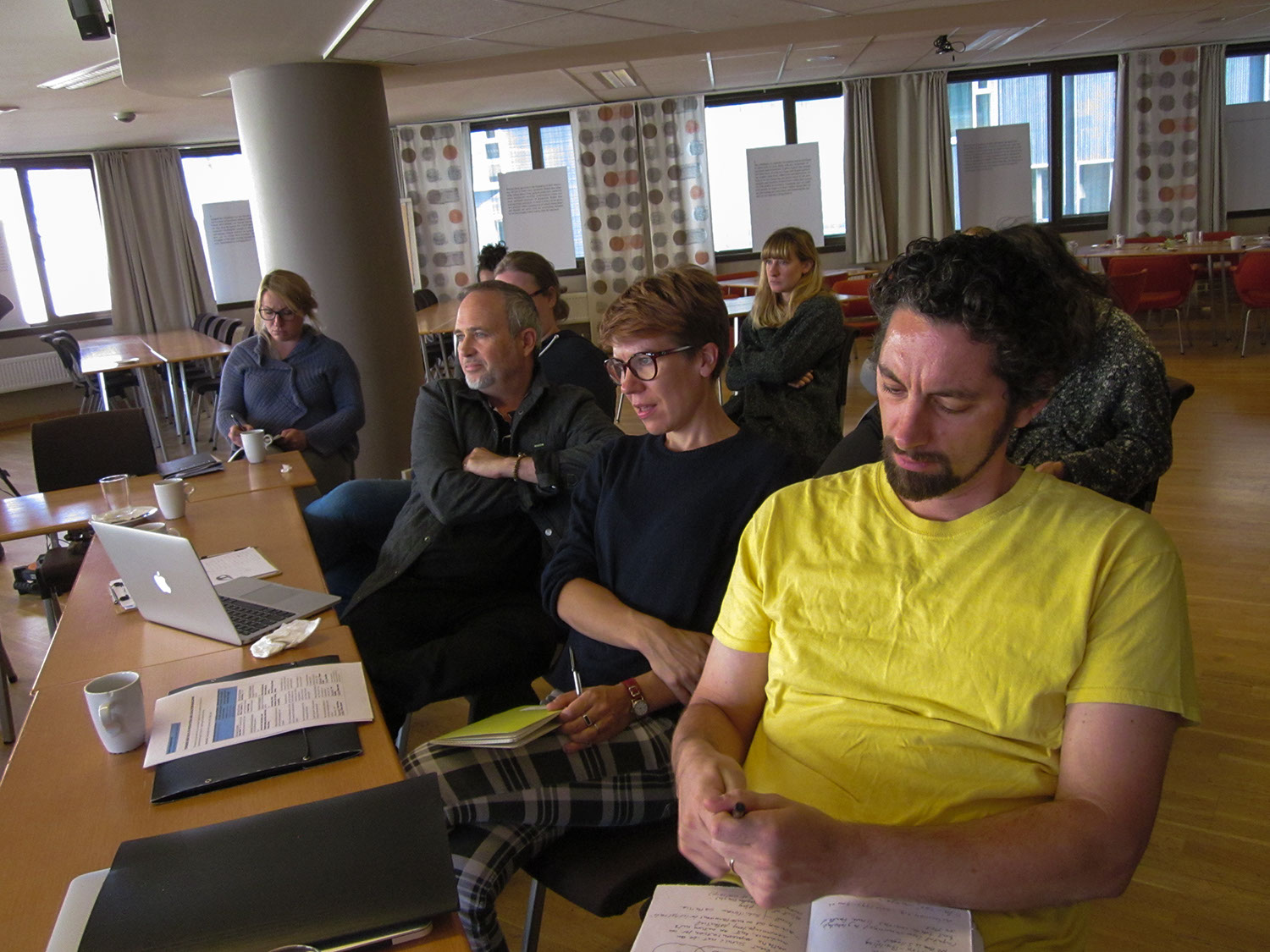
5 September 2015, Plenary session 2
Working group 2:
Situating precarity: Social stratification and increased precarity in the art world /differences in the level of precarity between artistic and non-artistic work
Contributors: Jelena Vesić (presenter), Jochen Becker, Vladan Jeremic, Marita Muukkonen, Jean-Baptiste Naudy, Kuba Szreder, Ivor Stodolsky
The input for the group discussing precarity was given by Kuba Szreder, who presented his concept of radical opportunism as a form of engagement within neoliberal conditions of production in culture.
In the following discussion it was stated that the neoliberal model of capitalist production, in which work is organized in short-term projects with changing employers and employees, brings forward flexible, opportunistic, competitive, short-term working contracts in the greater economy and in the art field.
It was problematized that precarious working conditions in the sense of freelance jobs have become paradigmatic in the cultural field and they are both, chosen and imposed. Therefore it is necessary to differentiate various levels of precarity: for example migrant workers that are deprived of any legal status and flexible and partly self-imposed working relations in project-oriented work.
Furthermore it was stated that opportunistic behavior and clientelistic networking typical for flexible labor conditions create structural exclusion and hinders the political organization of cultural workers. On the other hand, the dialectic between the growth of cultural industries and the growing capacity of self-organization was stressed, which furthers articulation and development of alternative cooperative economic models.
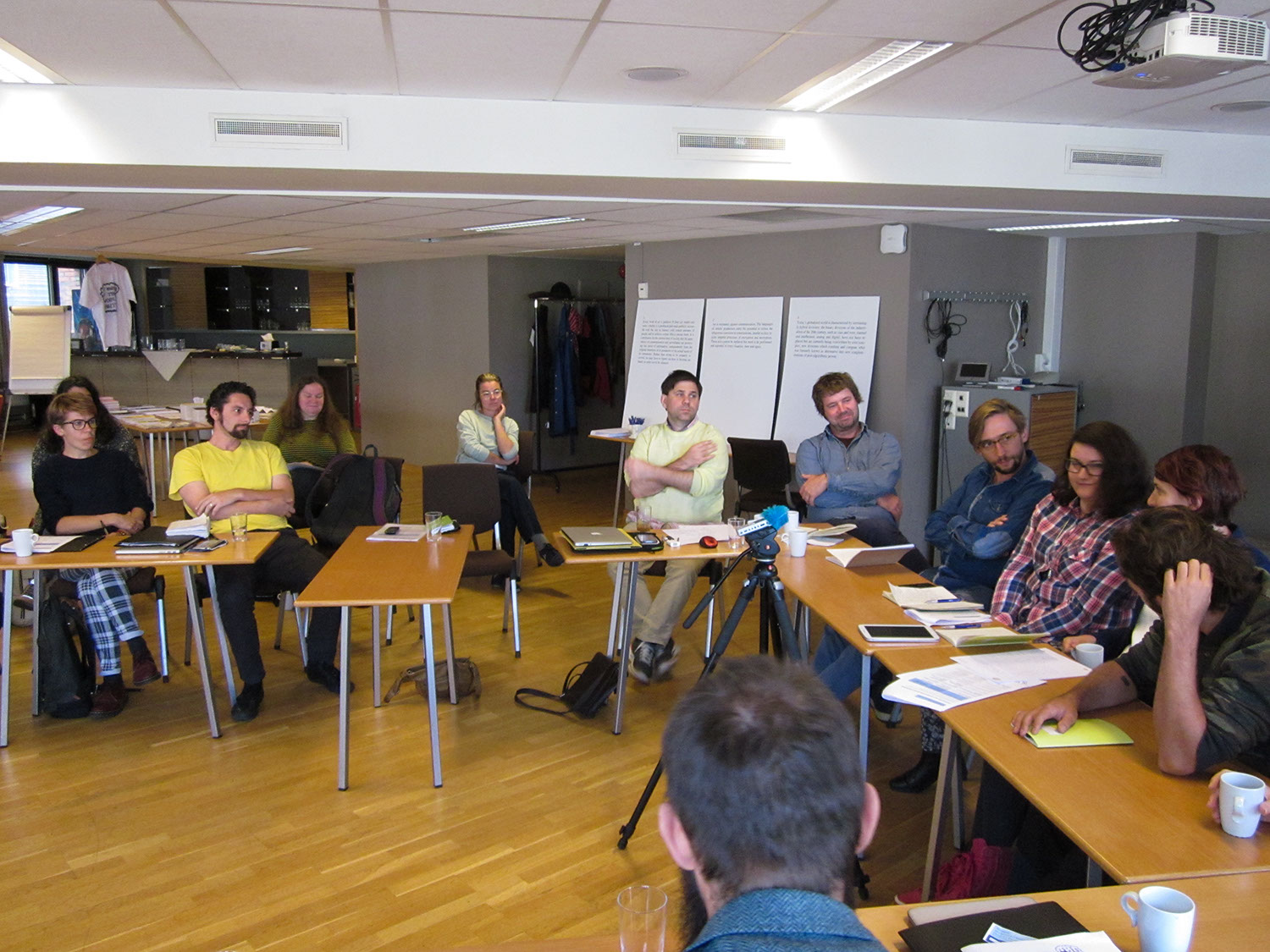
5 September 2015, Plenary Session 3 & discussion
Working group 3:
Valuation of artistic work: problems of quantification of work / Art and economic alternatives
Contributors: Airi Triisberg (presenter), Corina L. Apostol, Sissel M Bergh, Mourad El Garouge, Minna L. Henriksson, Lise Skou, Lise Soskolne, Raluca Voinea
The input for the discussion about valuation of artistic labor was given by Lise Soskolne. She presented the strategy of Working Artists and the Greater Economy (W.A.G.E.), a New York-based activist organization focused on regulating the payment of artist fees by nonprofit art institutions. The organization has developed a certification format for institutions that comply with minimum standards for the remuneration of artistic work, a strategy that relies on the “reputation economy” of the targeted art institutions. Currently W.A.G.E. is working on a complementary individual certification model functioning in direction of a union-like organization of workers.
During the discussion, two general strategies of framing artistic labor were elaborated, that conceptualize artistic labor either as commodity or as social contribution. The first subsumes artistic labor under wage labor, with the possibility to extend the demanded standards of payment to other workers in or even beyond art institutions. The possibility of internationalization of such standards was discussed. Examples of national standardization campaigns and reached agreements in Sweden and Poland were given.
A number of challenges of the “wage labor-strategy” were addressed, especially in a transnational context. The necessity of a relevant transnational counter-power able to pressure employers to meet wage demands and the complexity of standardization of payment within globalized working relations was emphasized. It was criticized that standardization also might imply exclusion of certain groups that cannot meet the established standards.
The critical distinction was made that W.A.G.E. does not subsume artistic labor under wage labor. A foundational principle of W.A.G.E. Certification is the fact that an artist fee is distinctly not a wage for the work of making art and is defined as payment for the work an artist does once they enter into a transactional relationship with an arts organization.
The group discussed the difficulties of framing artistic labor as wage labor, because there seems to be a strong resistance against that in the art field, and a certain desire to think about artistic labor as an exceptional form of labor. The point was made that if artistic work is understood as social contribution and not as a commodity it can serve as a model for the reconfiguration of the concept of labor, that would bring about a different model of economy.
Examples of alternative economies were discussed amongst them cooperatives based on exchange economies and their own currencies from Spain and Greece. It was underlined that alternative economies go together with a certain de-skilling of individual labor. The discussion ended with the open question how the reduction or even termination of division of labor would affect artistic practice within such economies.
Plenary Session 1, 6 September 2015
Working group 4:
Possibilities and difficulties of coalition-building beyond local and international constraints
Contributors: Ivor Stodolsky (presenter), Jochen Becker, Marita Muukkonen, Minna L. Henriksson, Sissel M Bergh, Vladan Jeremic
The input for the group working on possibilities and difficulties of coalition-building beyond local and international constraints was given by Minna Henriksson. She presented a case study about the Mänttä Art Festival in Finland, an annual exhibition project in the Finnish periphery that invited international artists without paying for fees and production. After examining particular problems of this case, general methods of finding common ground for building alliances were debated.
It was stated that for aligning with social movements, art has to locate itself in the wider social field. Starting from the universal common needs people share, more particular interests can be articulated and negotiated in the spirit of solidarity. In a local situation, community building can be achieved through spotting of specific issues, referendums, commoning of resources, building of project groups and collectives. The operaist method of co-research, a research method that intends to erase the border between researcher and the object of research, was proposed as method to find and define common demands.
As a central challenge to the communication between different groups the necessity of translation between different terminologies and “languages” was emphasized. It was stated that expert terminologies are important but need to be made accessible to communicate with other groups. Local knowledges and languages informed by cultural or social backgrounds need to be reformulated. In this respect it was underlined that art has the advantage of being a more “universal” form of communication. The point was made that the translation / reframing / reformulation of needs or problems into political demands is at the core of political empowerment and representation. Careful reformulation, translation and re-translation is especially important to find common grounds for alliances in trans-local contexts. This means that existing organizations need to develop the capacity to reformulate their problems, demands and political strategies keeping in mind a trans-local approach.
Another important issue of discussion was the need of adequate spaces for gathering and voicing demands. Spaces for meeting were found to be a precondition for finding common grounds and aligning of different groups and movements. In this context the question was raised if the spaces of the art world such as biennials and art fairs, can be at all considered suitable spaces for such purposes. It was stressed that a welcoming public space open to everyone needs to be created. In addition, the fact that one needs to be aware that these spaces are also open to recuperation from other forces was discussed.
In terms of language, the argument was made that for describing international alliances today it is necessary to find alternatives to the words “national” and “global” that stem from the discourse of capitalist market globalization and nation state politics. Instead of “inter-national” or “trans-national” the terms “trans-local” (rooted in more than one situation) or “pre-mondial” were proposed. The term “mondial” could be used for naming a ‘globalization from below’.
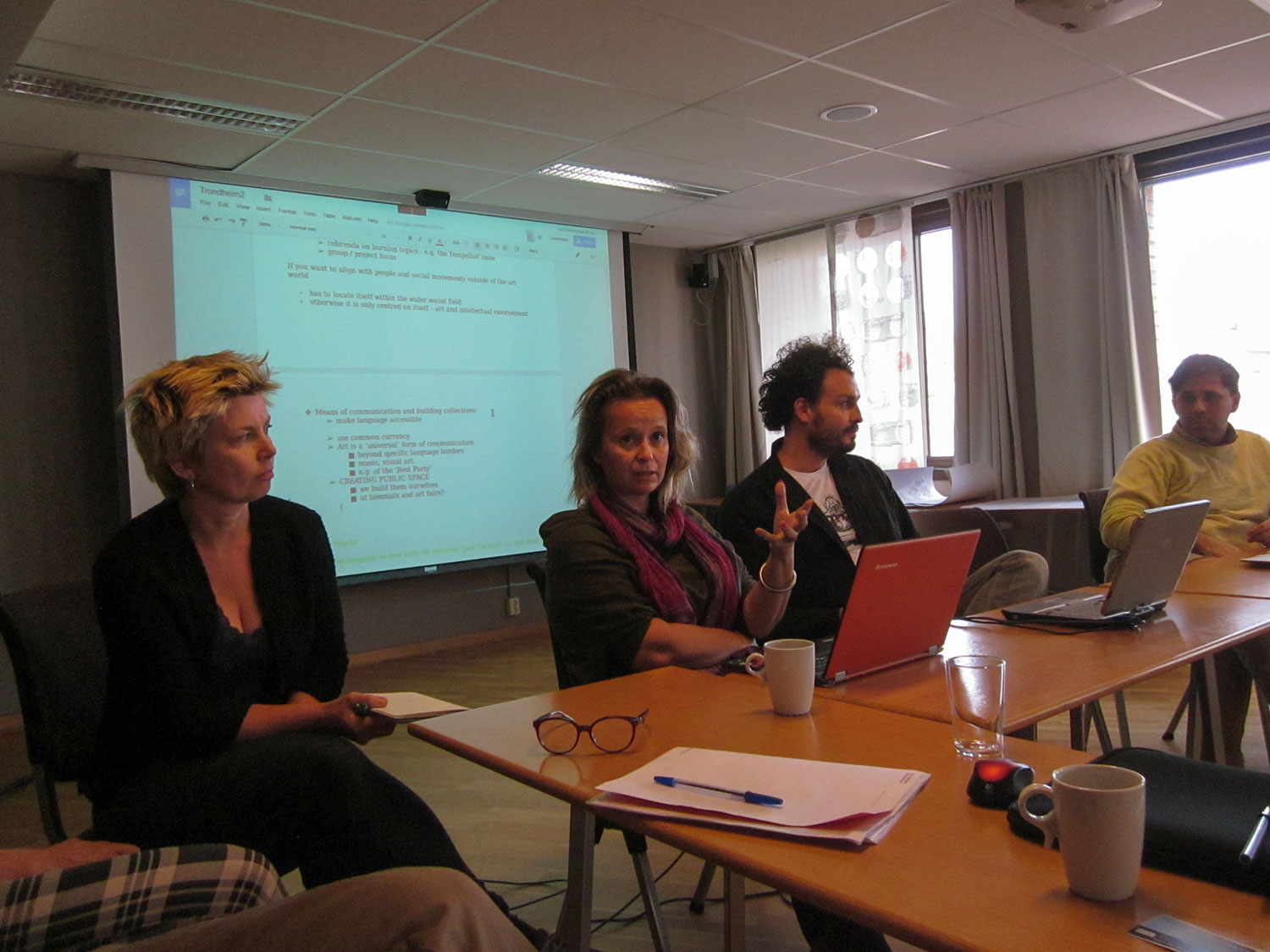
Plenary Session 2, 6 September 2015
Working group 5:
Transformative ways of art production: Artistic contribution as class struggle
Contributors: Raluca Voinea (presenter), Corina L. Apostol, Danilo Prnjat, Jean-Baptiste Naudy, Jelena Vesić, Jesper Alvær, Kuba Szreder, Lise Skou
The input for the group discussing transformative ways of art production was given by Jesper Alvær, who presented examples of his artistic research on art and labor. For the plenary session, the group prepared a collective statement to articulate contradictions and potentials of artistic practice that makes links with subjects positioned outside of the art field.
In the beginning it was stated that the group speaks from the position of artists and cultural workers. The group stressed that the emancipatory force of art can only be realized if art doesn’t exploit people in the interest of art but if art puts itself in the interest of the people. It was underlined that artists can use their privileges and status in a tactical way to support certain causes.
The relation to the institution of art was identified as main contradiction and the group called for the re-appropriation of the definition of social practice, but as well the re-appropriation of the notion of aesthetics from the institutions. The notion of aesthetics needs to be remobilized in a way that can (1) stimulate he imagination of the oppressed to form a liberating force not limited by conventions, (2) that can change the notion of the real, of what is normal and of what is acceptable. Playfulness was proposed as a tactic/strategy to counter rules and expectations.
In the plenum discussion problematized that artistic practice nevertheless remains bound and valued within the institution of art, although rules of the institution can be subverted and institutional space can be used tactically and playfully for non-art purposes and common social or political causes. It was underlined that artists must be aware of their manifold privileges when they join coalitions for social struggles with other groups. The artist can go out on the “playing field” of other social struggles and then return and harvest the value of his/her practice in the institution of art. However, the question of accumulation of cultural capital and funding come up. On the other hand, one can also lose, be blacklisted by either an institution or a movement.
The best meeting place for making coalitions was found to be outside of the art institutions, in the public space, on the streets. This is the “playing field” outside of safe boundaries of art institutions, where artists can show what contribution they have to offer for a common cause.
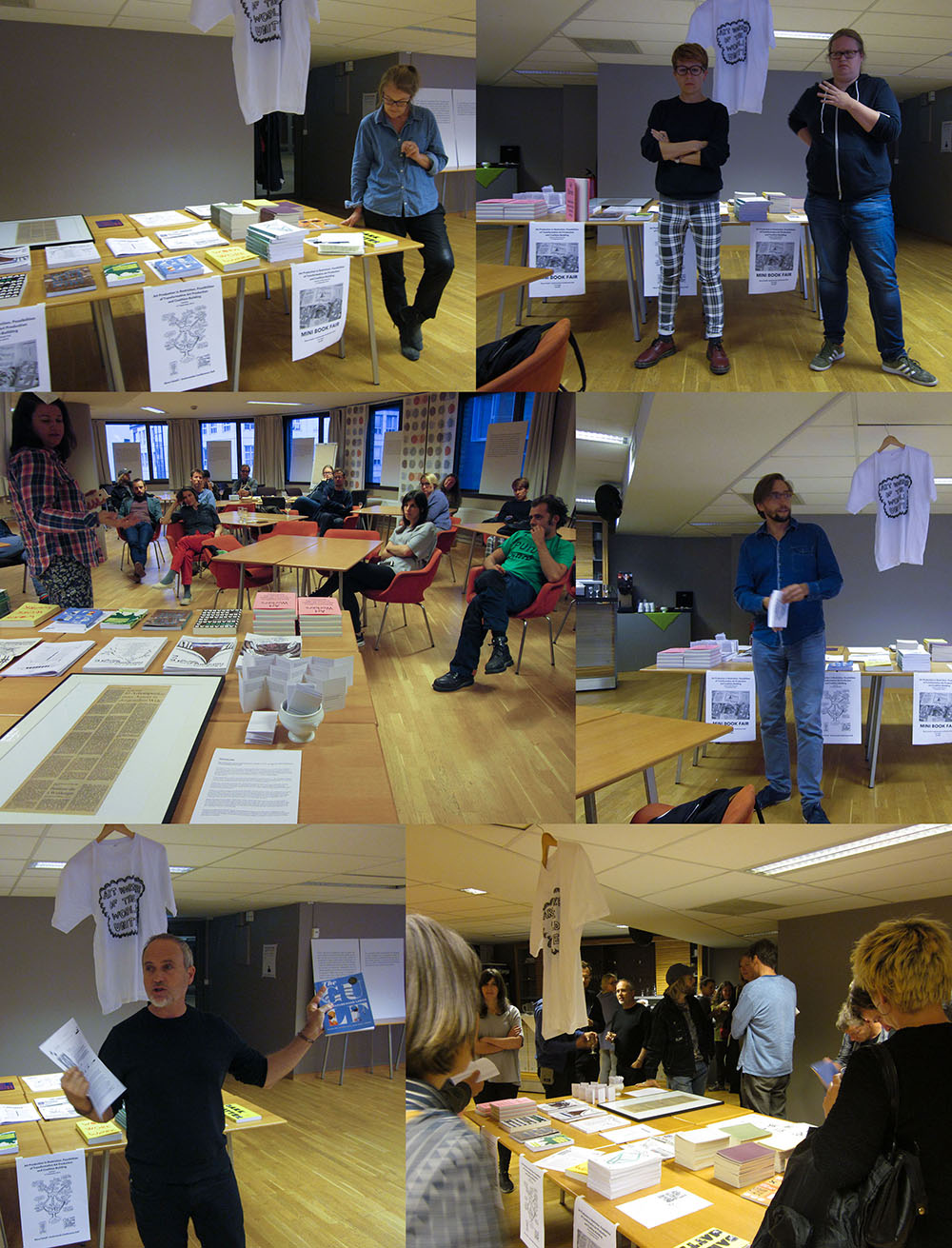
Plenary Session 3, 6 September 2015
Working group 6:
Aligning with social movements
Contributors: Gregory Sholette (presenter), Airi Triisberg, Lise Soskolne, Marina Vishmidt, Marius Lervåg Aasprong, Mourad El Garouge, Noah Fischer, Rena Raedle
The input for the group discussing alignment with other social movements was given by Noah Fischer. He reported on artists involvement in the Occupy Wall Street movement in 2011. Fischer described forms of organizing that emerged and gave examples of coalitions with social movements that came out from Occupy, such as the Art and Labor Group, Gulf Labor Coalition and G.U.L.F.
It was stated that in recent years a striking growth of coalitions between art and labor and art and justice campaigns can be noted, such as Gulf Labor Coalition, Liberate Tate, Australia, Precarious Workers Brigade, ArtLeaks, Art & Labor or the occurrence of labor strikes at the National Gallery London. It was proposed that the raise of consciousness about the relation between art and labor can be explained through the global economic crises and capital’s turn from generating surplus value based on labor towards pure forms of financialization.
In respect to these coalitions, the advantages and disadvantages of positioning / identifying the artist as artist or as worker were discussed. Both positions were elaborated.
On one side, art can be defended as a special kind of labor, that is useful to non-art political coalitions and social movements. Art helps to get media attention. Furthermore art and culture can generate and expand the collective embodiment of resistance and help to turn it into objective social forces.
The other position sees art as non-special work similar to any other type of precarious work, because it is part of the “social factory” (Mario Tronti), where all aspects of life are fully subordinated to capital. This common condition of precariousness and existential risk encourage the artists to build bridges to organized labor unions outside of the art world.
The need to distinguish two positions of the artist in the process of production, either as a wage laborer or as an entrepreneur, was discussed: either as workers that sell their labor or as entrepreneurs that employ others, produce commodities and sell them.
The group concluded that in order to become active outside the prescribed spaces of the art field a certain naïveté is required by the artist. The group argued that to operate within a social movement or any other coalition, the artist needs to take the risk of setting herself/himself aside and to actively forget certain conventions and habits of imminent critique or ever-growing cynicism. The notion of active naïveté by Antonio Negri was proposed to describe this relation towards moments and spaces from where coalitions can arise.
In the plenum, building solidarity was stressed as most important aspect in the process of coalition-building. The problem of patronizing attitudes was addressed. It was stated that solidarity arises from the joint struggle for mutual liberation and that objective class differences don’t need to result in patronization if coalitions are negotiated as partnerships. Within the movement, artists do not need to represent artists-authors, they are members that use their artistic competencies as part of and in solidarity with the movement.
We need to be aware that engagement in social struggles can reveal deep contradictions: self-exploitation, cooptation by institutions, parties, NGO’s, conservative and reactionary political attitudes, discrepancy between an idealized situation and a concrete political reality.
Conclusion: Findings, Agreed Points and Recommendations for Transformative Art Production and Coalition-Building
1. The Troubles with Artistic Labor
The contradictory character of artistic labor that can be described as both non-work and role model of labor has become paradigmatic for the general position of labor in modern relations of production. Artistic labor plays an important role in social reproduction – amongst many other forms of unpaid labor. To problematize this relation it makes perfect sense that artists redefine their labor as productive labor and, in line with this argument, claim “wage for work”. Even more so since the exploitative entrepreneurial norm artists are subjected to, has become a common norm of general precarious labor conditions. Yet this isn’t the end of the road. It is futile to differentiate artistic labor as manual or mental labor, as productive or unproductive work or as wage-labor or reproductive labor.
Nonetheless, the question remains: how do we break the social division of labor that produces art and labor as distinct spaces and categories? For that we need a re-distribution of work that represents the link through which artists can get involved in a common struggle, addressing their own working conditions. With the abolition of the division of labor, with the dissolution of the categories art / labor, artistic activity and the value of art would undergo a complete re-definition. Thus, the problematization of artistic labor and the material working conditions of artists is an eligible field where common ground needs to be found with other workers / non-workers.
2. Ways of Labor Struggle in the Arts
Artists’ unions and other artists organizations demand the standardization of fees to be implemented by state institutions and non-profit art institutions, based on either legal guarantees or voluntary certification of employing institutions. While the strategy of standardization of wage shows successes within local frameworks, limitations become obvious in transnational working relations of the art world. Standards would have to be relative to local living and working conditions, an institution that could control these standards doesn’t exist and localities or groups that don’t meet a minimum standard would be excluded from every scope of action.
Instead, individual commitment to dignified standards of labor and solidarity with local social struggles through withholding of labor, organized boycott of problematic art manifestations, solidarity or shaming campaigns and direct action against institutions disrespecting labor rights become powerful tools supporting a translocal struggle for transformation of labor on common basis. The symbolic act of withholding of labor from a biennale is a legitimate tool to support the cause of a local community. The effect of such boycott grows proportional to the cultural capital of an artist. More sustainable alliances with groups from outside the art-world require engagement of artists in the wider social field.
How and on which common ground these alliances can be build and where is the place of the artist within such coalitions?
3. Recommendations for Alliances and Coalition-Building
Finding common ground, from universal common needs to more particular interests, is the precondition of any alliance. Artists can help in the translation and re-translation, reformulation and reframing of needs and problems that are articulated by different groups. Translation between different terminologies and languages informed by social and cultural backgrounds gains importance in translocal approaches to finding common grounds. Art and culture are also powerful means to create cohesion and to form a collective identity of social movements.
In practice, artists share a common continuum with the general precarious condition of labor. Not only in the art world, opportunistic behavior and clientelistic networking typical for flexible labor conditions create structural exclusion and hinders the political organization of workers. A material distinction of the position of artists in the process of production can be made: There are artists who sell their labor and there are artists-entrepreneurs that employ others to produce commodities and sell them.
Another peculiarity that makes troubles in coalition-building between artists and non-art groups lies in the artists’ relationship towards the institution of art. It needs to be acknowledged that artistic practice stays bound and valued in the institution of art and therefrom a number of contradictions come up, when artists link their practice to the wider social field.
Rules of the institution can be subverted and institutional space can be used tactically for non-art purposes to gain visibility for common causes. Artists can use their privileges and they can re-appropriate the definition of social practice and aesthetics. The notion of aesthetics can be remobilized as a space for imagination and liberating force of the oppressed, that can change the notion of the real.
But the emancipatory force of art can only be realized if art doesn’t exploit social movements in the interest of art but if art becomes a means in the hands of the people. Alliances and coalitions can only become sustainable if solidarity is developed in a struggle for mutual liberation, and not through patronizing attitudes.
Consequently, the best meeting place for making coalitions is definitively the space outside of the institutions, because here it is where artists can show what their contribution to a common cause really is. To engage in social struggles can reveal deep contradictions: discrepancy between ideal and political reality, self-exploitation and cooptation by institutions, parties or NGO’s, confrontation with conservative and reactionary political forces and all forms of repression. For the artist, this might mean to give up certain peculiarities of the arts, such as for example authorship, or maybe an artistic career. And she needs to translate/reframe her/his practice in the light of particular competencies that might be useful for a certain cause.
To be part of a social movement or coalition, the artist needs to take the risk of setting herself/himself aside and to consciously block out certain conventions and habits of the art world, imposing either its imperative of criticality or omnipresent cynicism.
It is a ‘responsible playfulness’ or ‘conscious naiveté’ that allows the artist to be part of a moment and to enter the space from where coalitions towards transformation emerge.
This report was written by Rena Raedle and Vladan Jeremić in Belgrade, December 2015 and reviewed by Airi Triisberg, Corina L Apostol, Gregory Sholette, Lise Soskolne and Katja Praznik.
Contributors to the working groups were:
Airi Triisberg (Tallinn), Corina L Apostol (ArtLeaks, Bucharest), Danilo Prnjat (DeMaterijalizacija umetnosti, Belgrade), Gregory Sholette (New York), Ivor Stodolsky (Perpetuum Mobile, Berlin), Jean-Baptiste Naudy (Ateliers Populaires de Paris), Jelena Vesić (Belgrade), Jesper Alvær (Oslo), Jochen Becker (metroZones, Berlin), Kuba Szreder (Warsaw), Lise Skou (Aarhus), Lise Soskolne (W.A.G.E., New York), Marina Vishmidt (London), Marita Muukkonen (Perpetuum Mobile, Helsinki), Marius Lervåg Aasprong (Trondheim), Minna Henriksson (Helsinki), Mourad El Garouge (Ateliers Populaires de Paris), Noah Fischer (Occupy Museums, New York), Raluca Voinea (ArtLeaks, Bucharest), Sissel M Bergh (Trøndelag Bildende Kunstnere, Trondheim).
For more information about the seminar, related papers by the contributors and full documentation of plenary sessions see https://transformativeartproduction.net
The project was led by Anne-Gro Erikstad, project leader and curator at LevArt, project space for contemporary art of the Levanger Commune.
Preliminary research for this project was done during a residency of the artists at The Nordic Artists’ Centre.
Financial support for this project/seminar was provided by Arts Council Norway and Nordic Culture Point.
Thank you to all that made this happen!
Get text as pdf: conclusions_trondheim_seminar_150dpi.pdf
